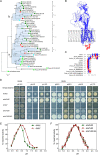Roles of plasma membrane proton ATPases AHA2 and AHA7 in normal growth of roots and root hairs in Arabidopsis thaliana
- PMID: 30238999
- PMCID: PMC7379730
- DOI: 10.1111/ppl.12842
Roles of plasma membrane proton ATPases AHA2 and AHA7 in normal growth of roots and root hairs in Arabidopsis thaliana
Abstract
Plasma membrane H+ -ATPase pumps build up the electrochemical H+ gradients that energize most other transport processes into and out of plant cells through channel proteins and secondary active carriers. In Arabidopsis thaliana, the AUTOINHIBITED PLASMA MEMBRANE H+ -ATPases AHA1, AHA2 and AHA7 are predominant in root epidermal cells. In contrast to other H+ -ATPases, we find that AHA7 is autoinhibited by a sequence present in the extracellular loop between transmembrane segments 7 and 8. Autoinhibition of pump activity was regulated by extracellular pH, suggesting negative feedback regulation of AHA7 during establishment of an H+ gradient. Due to genetic redundancy, it has proven difficult to test the role of AHA2 and AHA7, and mutant phenotypes have previously only been observed under nutrient stress conditions. Here, we investigated root and root hair growth under normal conditions in single and double mutants of AHA2 and AHA7. We find that AHA2 drives root cell expansion during growth but that, unexpectedly, restriction of root hair elongation is dependent on AHA2 and AHA7, with each having different roles in this process.
© 2018 The Authors. Physiologia Plantarum published by John Wiley & Sons Ltd on behalf of Scandinavian Plant Physiology Society.
Figures




Similar articles
-
Arabidopsis plasma membrane H+-ATPase genes AHA2 and AHA7 have distinct and overlapping roles in the modulation of root tip H+ efflux in response to low-phosphorus stress.J Exp Bot. 2017 Mar 1;68(7):1731-1741. doi: 10.1093/jxb/erx040. J Exp Bot. 2017. PMID: 28369625 Free PMC article.
-
Dissecting iron deficiency-induced proton extrusion in Arabidopsis roots.New Phytol. 2009;183(4):1072-1084. doi: 10.1111/j.1469-8137.2009.02908.x. Epub 2009 Jun 22. New Phytol. 2009. PMID: 19549134
-
The effect of a genetically reduced plasma membrane protonmotive force on vegetative growth of Arabidopsis.Plant Physiol. 2012 Mar;158(3):1158-71. doi: 10.1104/pp.111.189167. Epub 2012 Jan 3. Plant Physiol. 2012. PMID: 22214817 Free PMC article.
-
Regulation of the plasma membrane proton pump (H(+)-ATPase) by phosphorylation.Curr Opin Plant Biol. 2015 Dec;28:68-75. doi: 10.1016/j.pbi.2015.09.005. Epub 2015 Oct 24. Curr Opin Plant Biol. 2015. PMID: 26476298 Free PMC article. Review.
-
Tripartite hormonal regulation of plasma membrane H+-ATPase activity.Trends Plant Sci. 2022 Jun;27(6):588-600. doi: 10.1016/j.tplants.2021.12.011. Epub 2022 Jan 13. Trends Plant Sci. 2022. PMID: 35034860 Review.
Cited by
-
Fine mapping of a leaf flattening gene Bralcm through BSR-Seq in Chinese cabbage (Brassica rapa L. ssp. pekinensis).Sci Rep. 2020 Aug 18;10(1):13924. doi: 10.1038/s41598-020-70975-2. Sci Rep. 2020. PMID: 32811880 Free PMC article.
-
MPK6 Kinase Regulates Plasma Membrane H+-ATPase Activity in Cold Acclimation.Int J Mol Sci. 2021 Jun 13;22(12):6338. doi: 10.3390/ijms22126338. Int J Mol Sci. 2021. PMID: 34199294 Free PMC article.
-
Plasma membrane-localized H+-ATPase OsAHA3 functions in saline-alkaline stress tolerance in rice.Plant Cell Rep. 2023 Dec 22;43(1):9. doi: 10.1007/s00299-023-03103-9. Plant Cell Rep. 2023. PMID: 38133824
-
The evolution of plant proton pump regulation via the R domain may have facilitated plant terrestrialization.Commun Biol. 2022 Nov 29;5(1):1312. doi: 10.1038/s42003-022-04291-y. Commun Biol. 2022. PMID: 36446861 Free PMC article.
-
The root apoplastic pH as an integrator of plant signaling.Front Plant Sci. 2022 Aug 23;13:931979. doi: 10.3389/fpls.2022.931979. eCollection 2022. Front Plant Sci. 2022. PMID: 36082302 Free PMC article. Review.
References
-
- Abascal F, Zardoya R, Posada D (2005) ProtTest: selection of best‐fit models of protein evolution. Bioinformatics 21: 2104–2105 - PubMed
-
- Axelsen KB, Venema K, Jahn T, Baunsgaard L, Palmgren MG (1999) Molecular dissection of the C‐terminal regulatory domain of the plant plasma membrane H+‐ATPase AHA2: mapping of residues that when altered give rise to an activated enzyme. Biochemistry 38: 7227–7234 - PubMed
-
- Baginski ES, Foa PP, Zak B (1967) Microdetermination of inorganic phosphate, phospholipids, and total phosphate in biologic materials. Clin Chem 13: 326–332 - PubMed
MeSH terms
Substances
Grants and funding
LinkOut - more resources
Full Text Sources
Other Literature Sources
Molecular Biology Databases

